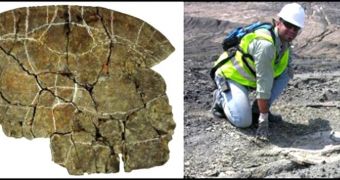A group of investigators peering deep inside a Colombian coal mine were recently able to identify the remains of a species of turtle that stands out from the crowd. Some types of turtles are very large, while others are extremely small, but this particular species stands out not through its dimensions, but through the thickness of its shell. According to the scientists who found it, the fossil appeared to be sporting a carapace that was about as thick as a 400-page book, Wired reports.
It may be, the team hypothesizes, that the animal used this very tough coating to protect itself from giant predators in its environment, including prehistoric crocodiles, and maybe even the Titanoboa cerrejonensisa, the largest snake ever discovered. This particular reptile had a length of 42 feet, weighed up to a ton, and lived more than 60 million years ago, after the disappearance of the dinosaurs. It is generally considered that T. cerrejonensisa is the ancestor of modern boa constrictors. This creature would have posed a considerable threat to all sorts of other animals, including turtles.
The recently-found fossil was named Cerrejonemys wayuunaiki, using words from the language of the native Wayuu people, who inhabit the region. The age of the samples was established to be around 60 million years, which means that this species also lived after the dinosaurs were wiped off, during the Cretaceous-Tertiary (K-T) extinction event. The massive dying took place about 65 million years ago. The turtle was discovered by a team of US researchers, who are based at the Smithsonian Tropical Research Institute (STRI), and the Florida Museum of Natural History. The experts announced the finding in a press release published on April 5.
“The fossils from Cerrejon provide a snapshot of the first modern rainforest in South America - after the big Cretaceous extinctions and before the Andes rose, modern river basins formed and the Panama land bridge connected North and South America,” explains STRI scientist and team member Carlos Jarmillo, who studies the plant life that existed at that time. “I hope this will give us an even better understanding of turtle diversity in the region and some important clues about the environment where they lived,” says North Carolina State University (NC State) Edwin Cadena, the first author of the paper detailing C. wayuunaiki. The work appears in the latest issue of the Journal of Vertebrate Paleontology.

 14 DAY TRIAL //
14 DAY TRIAL //